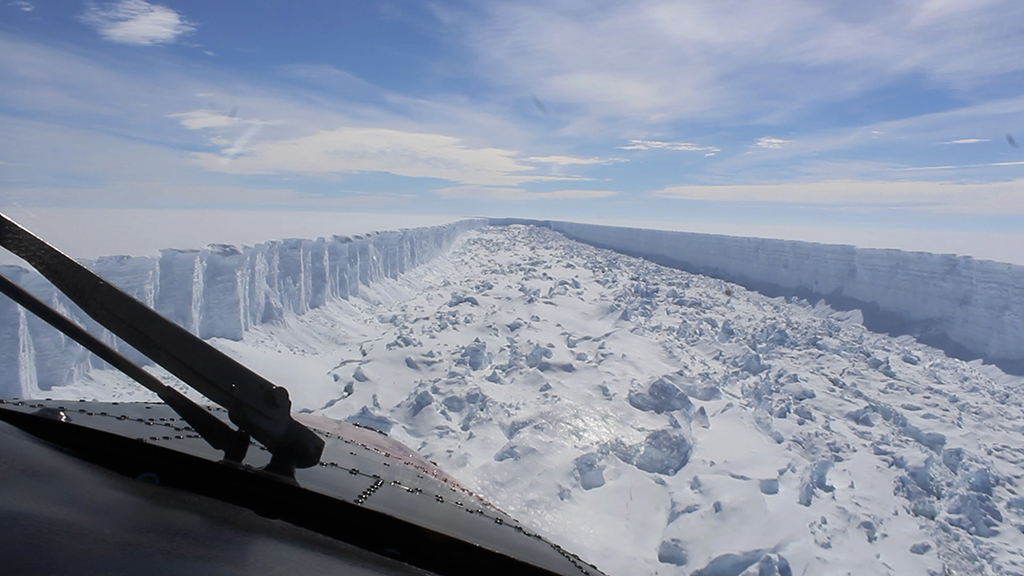A chunk of Antarctic ice that was one of the biggest icebergs ever seen has met its end near South Georgia. Scientists will be studying its effects on the ecosystem around the island for some time.
Perhaps you remember iceberg A68a, which enjoyed a few minutes of fame back in 2017 when it broke off an ice shelf on the Antarctic Peninsula. Hardly your everyday iceberg, it was one of the biggest ever seen, more than 100 miles long and 30 miles wide.
The iceberg drifted slowly through the icy Weddell Sea for a few years, before picking up steam as it entered the Southern Ocean. When last we heard from it, in 2020, it was bearing down on the island of South Georgia in the South Atlantic, a bit shrunken and battered from a journey of more than a thousand miles.
Alas, ol’ A68a is no more. Last year, some 100 miles from South Georgia, it finally did what all icebergs eventually do: thinned so much that it broke up into small pieces that eventually drifted off to nothingness.
In its prime, A68a was nearly 800 feet thick, though all but 120 feet of that was hidden below the waterline.
Ecologists and others had feared that during its journey the iceberg might become grounded near South Georgia. That could have kept the millions of penguins and seals that live and breed there from reaching their feeding areas in the ocean.
That didn’t happen. New research shows that A68a performed more of a drive-by and most likely only struck a feature on the seafloor briefly as it turned and kept going until it broke up.
But the research also revealed another potential threat from the iceberg to ecosystems around South Georgia. As it traveled through the relatively warm waters of the Southern Ocean into the South Atlantic, it melted from below, eventually releasing a huge quantity of fresh water into the sea near the island. The influx of so much fresh water could affect plankton and other organisms in the marine food chain.
The scientists, led by Anne Braakmann-Folgmann, a doctoral student at the Center for Polar Observation and Modeling at the University of Leeds in Britain, used satellite imagery to monitor the shape and location of the iceberg over the course of its journey. (Like other large Antarctic icebergs, it was named according to a convention established by the U.S. National Ice Center, which is a bit less flashy than the one used for hurricanes.)
The imagery showed how the area of the iceberg changed over time. The researchers also determined its thickness using data from satellites that measure ice height. By the time it broke up, Ms. Braakmann-Folgmann said, A68a was more than 200 feet thinner overall.
A68a left its mark. The researchers, whose findings were published in the journal Remote Sensing of Environment, estimated that melting in the vicinity of South Georgia resulted in the release of about 150 billion tons of fresh water. That’s enough to fill an Olympic-size swimming pool 61 million times over, the researchers said, although because the ice was already floating its melting did not contribute to sea-level rise.
Not only is the water fresh, not salty, but it also contains a large amount of iron and other nutrients. Ms. Braakmann-Folgmann is helping another group of researchers, from the British Antarctic Survey, who are trying to determine the ecological effects of the iceberg and the meltwater.
When the iceberg was near South Georgia, scientists with the survey were able to deploy autonomous underwater gliders to take water samples. On the island, they used tracking devices on some gentoo penguins and fur seals, to see whether the presence of the iceberg affected their foraging behavior.
Understand the Latest News on Climate Change
Gone, but not forgotten. A68a, one of the biggest icebergs ever seen, broke off an ice shelf on the Antarctic Peninsula in 2017, drifted slowly for a few years and eventually melted in 2021. Here is what new research tells us about its journey and potential effects.
Geraint Tarling, a biological oceanographer with the survey, said that preliminary findings from the tracking data showed that the penguins and seals did not alter foraging routes, as they might have had the iceberg blocked their way or affected their prey.
“At least in the areas of the colonies that we saw, the impacts from the iceberg itself are not as devastating as we first feared,” Dr. Tarling said.
But there is still much data to analyze, Dr. Tarling suggested, especially the water samples. A large influx of fresh water on the surface could affect the growth of phytoplankton, at the lower end of the food change, or it could alter the mix of phytoplankton species available, he said.
Complicating the analysis is that 2020, when the iceberg was nearing South Georgia, also happened to be a bad year for krill, the small crustaceans that are just above phytoplankton in the food chain.
Dr. Tarling said that although A68a did not become grounded, a few other large icebergs have in recent decades. Grounding and dragging of an iceberg can wreak havoc on ecosystems on or near the seafloor, he said.
And climate change could potentially lead to more grounding episodes. Warming is causing parts of the huge Antarctic ice sheets to flow faster toward the ocean, leading to more calving of icebergs that then travel north.
“What we’re looking at is a lot more movement of icebergs that could actually gouge these areas of the sea floor,” Dr. Tarling said.


























